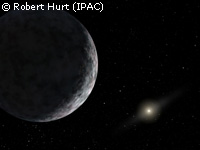Astronomers announce discovery of 'tenth planet'
US astronomers have discovered what they describe as a 'tenth planet' orbiting the Sun. The object, temporarily known as 2003 UB313, is slightly larger than Pluto and 97 times further from the Sun than the Earth is, making it the most distant object ever seen in the Solar System. The discovery was made by Michael Brown of Caltech, Chad Trujillo from the Gemini Observatory in Hawaii, and David Rabinowitz of Yale University. The trio first spotted the new planet in 2003 as part of a long-term survey for large objects in the Kuiper belt, the string of icy objects including Pluto that orbit beyond Neptune. Dr Rabinowitz told the BBC: 'It has been a remarkable day and a remarkable year. 2003 UB313 is probably larger than Pluto. It is fainter than Pluto, but three times further away. Brought to the same distance from the Sun as Pluto, it would be brighter. So today, the world knows that Pluto is not unique. There are other Plutos, just farther out in the Solar System where they are a little harder to find.' The team has yet to propose a formal name for the planet, but unconfirmed reports suggest that they would like to call it Xena, after a fictional warrior princess in a 1990s television series. Since their initial discovery, the astronomers have been carrying out more observations and calculations in order to try to confirm details such as the size and brightness of the planet. They believe that it is close to the most distant point of its 560-year orbit around the Sun - at its nearest, the planet will be just 36 times further from the Sun than Earth is. Unusually, its orbit is tilted some 44 degrees from the orbital plane of most of the other planets, which Dr Brown believes could be the result of a series of close encounters with Neptune. Estimating the size of the planet has proven more difficult, because although its brightness is known, astronomers also need to know what fraction of incident light it reflects. The object is too distant and cold to be picked up by the infrared telescopes that could provide that information. Nevertheless, the team believe that the planet must reflect between 50 and 100 per cent of incident light, making it larger than the 2,300-kilometre diameter of Pluto, but no larger than 3,000 km in total. The team had hoped to be more sure of the details before announcing their discovery, but first astronomers in Spain independently discovered another large object in the Kuiper belt that the US team had also spotted, and reports claim that unknown hackers then stole some of the team's data with the intention of publishing it, prompting them to publish their findings. One likely outcome of the discovery will be to add fuel to the debate over how exactly a planet should be defined. Some astronomers feel that Pluto itself is simply an 'overgrown Kuiper-belt object', while others argue that it should remain a major planet. The discovery of 2003 UB313 may force the International Astronomical Union to come up with a formal definition.
Countries
United States



